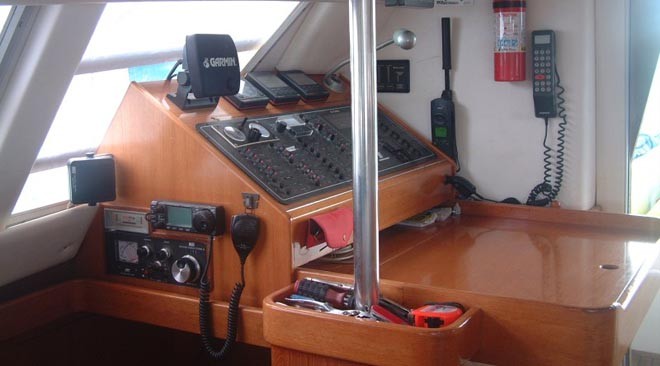HF-SSB’s role onboard in new age of sat-comms — World Cruising news
by David Schmidt, Sail-World Cruising Editor on 24 Jul 2015

In times of distress will you pick up that satphone or put out a call on the radio? Allan Riches explains SW
For years, we have sailed with a High-Frequency Single-Sideband radio (HF-SSB) radio on my family’s J/44, and for years the device has quietly sat, hardly ever switched on.
Sure, it got a small bit of use when sailing to Bermuda, and my Dad played with it during one of our myriad trips across the Gulf of Maine, but for the vast majority of its life, the unit has sat unused, occupying space in the nav station and begging the question: Is this thing even worth its weight to carry onboard? The answer largely depends on where you sail, and what else you might carry onboard.
HF-SSB radios were invented decades before the advent of satellite communications and were designed to facilitate very long-range communications, both from land stations and from vessels.
Over time, various cruisers nets were established using HF-SSB, and more contemporary models also allow users to receive AM and FM radio stations (likely the reason that my Dad-a die-hard baseball fan-was fiddling with the SSB off the coast of Canada), short-wave stations and ham-radio frequencies.
Moreover, DSC-enabled HF-SSB allows mariners to broadcast distress calls that include their GPS position information (provided, of course, that they properly networked their HF-SSB to their GPS and properly obtained and entered their unique MMSI number-both critical steps). Add a Pactor modem to the mix and cruisers can inexpensively send email (via SailMail) and download GRIB weather files.
For some cruisers, however, HF-SSB radios can be tricky to use, as operators must manually enter their desired frequency (ranging from 2 MHz to 26 MHz), which the radio bounces off of the Earth’s upper atmosphere before returning to the Earth’s surface. Enter the wrong frequency (based on the time of day and the distances involved) and your call will likely either fall shy of it’s intended mark or skip over it, ensuring a lost communication. Generally the higher the sun, the higher the frequency required for effective communications.
Spend enough time using HF-SSB radios, and selecting the right frequency becomes considerably easier, but first-time users should plan on some initial teething pains or-ideally-organize some HF-SSB coaching sessions with a more knowledgeable user or do a radio operators course.
Still, that nagging question remains-why carry HF-SSB in a world of satellite-communication terminals (read: domes), sat-phones, EPIRBs, Personal Locator Beacons (PLBs) and other modern, long-range communication solutions?
For starters, HF-SSB is a less expensive than most satellite-communication terminals, and HF-SSB calls are free, which is a much better bargain than sat-comms calls, which are not cheap (although costs have dropped compared to previous years). Also, a call that’s made via a satellite phone is just that: a point-to-point call that’s made between two discreet parties. An HF-SSB call, however, is a radio transmission that can be received by any other HF-SSB users in a given area who are tuned to a given frequency. This can have big benefits for emergency calls, but-depending on the type of emergency-an EPIRB or a PLB can be even more effective at alerting a rescuing authority of an ongoing emergency.
Also, some sat-comms systems only work in designated areas on the globe (for example, some systems exclude the high latitudes or areas deep in the South Pacific), so HF-SSB can be used to help fill in these dark spots on the planet. (Alternatively, of course, users can also just buy sat-comms equipment that works globally).
Moreover, some long range passages such as the Coconut Milk Run, which takes sailors from Panama to Australia- still rely heavily on this equipment for the daily social networking calls. Its mandatory for some big bluewater races like the Sydney to Hobart but these days for some oher races such as Transpac, now rely on either voice calls over sat phones or email.
So, should you buy an HF-SSB unit for your boat? This entirely depends on where you cruise, as well as the other equipment that you carry onboard, as well as the depth of your cruising kitty. If resources are not a problem and you’re looking for the most user-friendly way of keeping in touch with friends and family ashore, a truly global sat phone or a sat-comms terminal are likely the way to go, provided, of course, that you also sail with an EPIRB and a full compliment of PLBs.
But, if resources are a bit more limited, or if you have sat-comms equipment that’s limited in its coverage map, an HF-SSB could be a good solution for sailing the South Pacific or for exploring South Georgia Island, provided, of course, that you’ve mastered the art of dialing-in your frequencies and that you don’t mind other HF-SSB users potentially listening-in on your non-emergency call. Additionally, HF-SSB allows you to participate in different cruisers nets, which can be a useful way of gathering news or weather or just hearing another human voice during a long and lonely offshore passage.
Speaking of long offshore passages, be sure to check out our coverage-inside this issue- of the 2015 Multihull Solutions Sail 2 Indonesia Rally, experience Fatu Hiva in the Marquesas through the eyes of cruisers Andrew and Clare Payne, and be sure to get the latest news about piracy in Southeast Asia. .
May the four winds blow you safely home,
If you want to link to this article then please use this URL: www.sail-world.com/136770